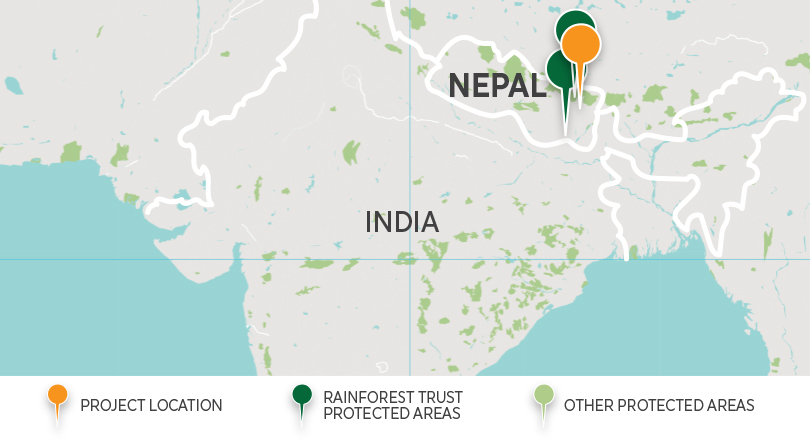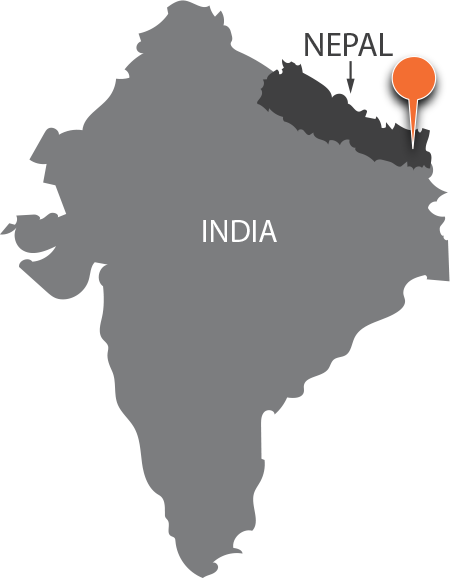Nearly one acre of forest is lost every second
27M+ ACRES SAVED
Thanks to generous support from our donors, we have successfully reached our fundraising goal for this project.
Stop Road Construction in the Himalayas
Rainforest Trust and our long-time partner, KTK-BELT have been working to create a corridor of protection for wildlife across eastern Nepal. Our newest joint initiative is the creation of a 136,331-acre community protected area in the Tinjure-Milkhe-Jaljale (TMJ) Rhododendron Forest. This designation follows the successful purchase of 150 acres by Rainforest Trust and KTK-BELT last year, fortifying a core portion of the region and preventing road encroachment.
The TMJ is one of the most unique habitats in the country’s Himalayan region. Consisting of 33 high altitude lakes and 13 watersheds, the TMJ is a vital resource to local communities and lifeline for many iconic species. But currently, bulldozers for haphazard road construction and unsustainable development are scattered across the TMJ landscape, leaving the area’s forests, wetlands, and shrub lands vulnerable. Header Photo: Red Panda, by Mathias Appel/Flickr.
COUNTRY
Nepal
ACRES
136,331
COST PER ACRE
$5.38
SPECIES
Spikenard (CR); Red-headed Vulture (CR); White-rumped Vulture (CR); Red Panda (EN); Alpine Musk Deer (EN); Atis (EN); East Himalayan Yew (EN)
(CR)=Critically Endangered, (EN)=Endangered
ACRES PRESERVED BY
Declaration
PARTNER
KTK-BELT
CARBON STORAGE
15,865,704 mT*
*(metric tonnes of CO2 equivalents)
Protect Globally Important Planet Species
Known as the ‘Rhododendron Capital of the Himalayas’, there are 28 species of rhododendrons and more than a thousand different plant species, of which more than 100 are endemic. Many plants and fungi used in traditional and modern medicine are also native to this area such as the Critically Endangered Spikenard and the Endangered Atis.
The TMJ falls within the Eastern Himalayas biodiversity hotspot and the Tamur valley and watershed Key Biodiversity Area, housing many endangered species including Critically Endangered Red-headed Vulture and White-rumped Vulture, as well as the Endangered Red Panda. In addition, the area is renowned for the presence of many wintering bird species such as Snow Partridge, Himalayan Monal, Rufous-winged Fulvetta, Rusty-cheeked Scimitar Babbler, Endangered Steppe Eagle and many others.
Support Local Communities
Engaged local communities are critical for long-term conservation success. Your gift to this project will also help KTK-BELT establish “Learning Grounds,”––educational centers for local people to work on creating direct links between the capacity of their community and the sustainability of the protected area. Photos: (Above) Flora and Fauna in the TMJ, by KTK-BELT; (Below) Rhododendron forests, by Maria Tim/Shutterstock.
Project Location

Learn More About This and Other Related Projects:
 Statement on Wildfires, Loss of Biodiversity & the Climate Crisis
Statement on Wildfires, Loss of Biodiversity & the Climate Crisis Connecting Nepal’s Rhododendron Forests
Connecting Nepal’s Rhododendron Forests Connecting a Vertical Community for Conservation
Connecting a Vertical Community for Conservation Conservation Organizations Purchase Critical Properties for Wildlife in Nepal
Conservation Organizations Purchase Critical Properties for Wildlife in Nepal Safeguarding Snow Leopard Lakes of the Himalayas
Safeguarding Snow Leopard Lakes of the Himalayas Creating the Red Panda Community Forest
Creating the Red Panda Community Forest Red Panda Sightings Inspire Conservation Work
Red Panda Sightings Inspire Conservation Work Voices from the Rainforest: Hiralal Sardar, Rainforest Trust Conservation Guardian
Voices from the Rainforest: Hiralal Sardar, Rainforest Trust Conservation Guardian
Thanks to the generous support of our Board members and other supporters who cover all of our operating expenses, Rainforest Trust is able to allocate 100% of donations to conservation action. No board member receives financial benefit and our staff salaries are modest.
Rainforest Trust is a registered 501(c)(3) nonprofit organization.
Quicklinks
Headquarters
To Visit Us:
7200 Lineweaver Road
Suite 100
Vint Hill, VA 20187
For Mailings:
P.O. Box 841
Warrenton, VA 20188
To Call Us:
(800) 456-4930
EIN: 13-3500609
CFC #11257




